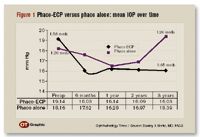Article
Large study supports combination phaco-ECP
Author(s):
Las Vegas-Combined phacoemulsifi-cation with endocyclophotocoagulation (phaco-ECP) can be beneficial for patients with medically controlled glaucoma who are undergoing cataract surgery, according to long-term follow-up results, said Stanley J. Berke, MD, FACS, at the annual meeting of the American Academy of Ophthalmology.

Patients who underwent the combination procedure had significantly lower IOP with a significant reduction in medication need compared with those who had undergone phaco alone, and those benefits were achieved without any increase in early or late complications, said Dr. Berke, associate clinical professor of ophthalmology and visual sciences, Albert Einstein College of Medicine, Bronx, NY.
He reported the results from a single group practice study in which 707 patients were randomly assigned to undergo phaco-ECP (626 eyes) or phaco alone (81 eyes). Data collected during a mean follow-up of 3.2 years (range, 0.5 to 5.8 years) showed that in both surgical groups, IOP decreased initially. With extended follow-up, mean IOP, however, remained lowered from baseline in the phaco-ECP group, and average medication use was also decreased. In contrast, mean IOP increased progressively after 2 and 3 years following phaco without any change in the mean number of medications used per patient.

The 707 eyes in the study were operated on by Dr. Berke and four of his colleagues from his private practice group, Ophthalmic Consultants of Long Island. The randomization ratio for allocating patients to the phaco-ECP and phaco groups was determined as appropriate by a biostatistician for meeting the investigators' objectives of accruing a robust group of patients in the phaco-ECP arm but with a sufficient number of controls for statistical analysis, Dr. Berke explained.
All the procedures were performed using topical/intracameral anesthesia or a peribulbar block and through a clear corneal or scleral tunnel incision. Eyes undergoing ECP were treated to achieve the desired tissue effect, which was whitening and shrinking of the ciliary processes. The entire ciliary process was treated, and the treatment zone ranged from 180° to 360°.
Dr. Berke noted that his personal preference when performing ECP is to use a curved probe through a single phaco incision to achieve 270° of treatment.
"Experience with ECP suggests that the surgeon should treat a minimum of 270° to attain good IOP reduction," he said.
All eyes in the study had one of two models of a foldable, three-piece silicone IOL implanted, and the same postoperative medication regimen, including a topical anti-biotic, nonsteroidal anti-inflammatory drug, and corticosteroid, was used in all cases.
Existing IOP-lowering medications initially were maintained and then eliminated one at a time if the treating physician believed IOP reduction was adequate for the patient's optic nerve and visual field.
Newsletter
Don’t miss out—get Ophthalmology Times updates on the latest clinical advancements and expert interviews, straight to your inbox.




